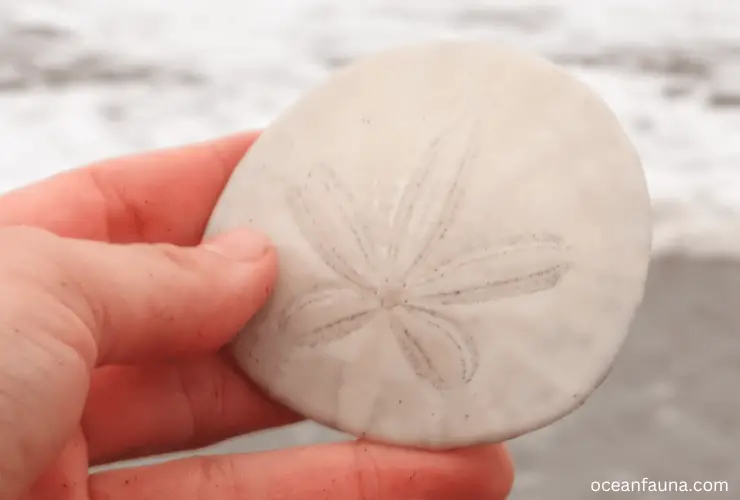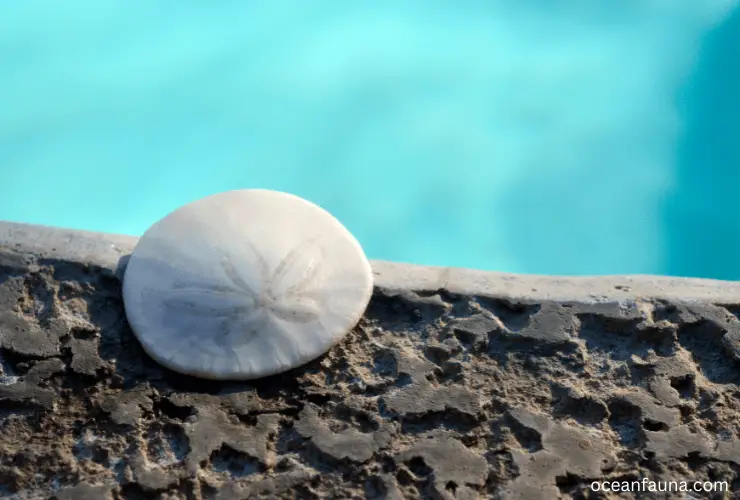Luckily, Sand dollars do not bite. However, they are still somewhat safe. You must be careful when handling the underside of a sand dollar because its long spines can cause puncture wounds. If their tiny bones puncture the skin, you might feel a burning sensation too.
Sand dollars are mostly found on the temperate and tropical zones of Central and South American sea coasts. If you live anywhere in that zone and have found a sand dollar, you must be feeling fortunate than harmful.
Now that we know that sand dollars aren’t that harmful let’s find out more about these rare sea urchins.
What is a Sand Dollar? (Appearance and Habitat)
To start, let’s see what a sand dollar even is. A sand dollar is a species of sea urchin that is relatively flat. The round, biscuit-shaped sea urchin is also known as a ‘sand cookie’ or even a ‘snapper biscuit’ sometimes.
These sand dollars aren’t that big at all. They are mostly about 3-4 inches long and have a skeleton known as a test. The test is usually in a fivefold symmetrical pattern made of calcium carbonate plates.
Some sand dollars have a soft spine that can help them stay put and not get washed away by the ocean waves.
One of the most exciting parts is that these sand cookies can be seen in various colors! These vary from shades of greens, blues, violets, and even purples. Sand dollars live in warm waters and remain under sandy surfaces or below the average water line.
What Happens if You Touch a Sand Dollar?
Just like picking up stranded seashells that you find at the beach, you should pick a sand dollar up too. Despite your curiosity, you might wonder if anything wrong will happen to you when you touch a sand dollar.

Let’s find out what really happens.
Touching a sand dollar is relatively harmless. However, its bones might cause a puncture wound that might end up causing a little burning sensation.
The worst that can happen is that your puncture wound can get infected, which is something you may not want to happen, so it’s best to leave the little sea creature alone even though it will not harm you.
Can an Alive Sand Dollars Kill or Hurt You? How Dangerous are These Creatures?
The standard Sand dollars are one of the least harmful species of sea urchins. However, some uncommon sand dollars or relatives of sand dollars may have potential harms you want to be aware of.
One of the potential dangers that we have spoken about a lot is their spines. Some relatives of sand dollars, which are just other species of sand dollars, have spines that are very long, spiky, and can even be poisonous.
Unlike these harmful species of sea urchins, sand dollars’ spines are soft and have no venomous substance inside or outside their bones. Hence, they are very harmless.
Another potential danger is the yellowish liquid that these creatures produce. This substance is usually produced on two possibilities; one is to protect themselves from blood injuries.
The other possibility is to defend themselves from predators. This yellow substance is completely non-venomous and is just a sign of whether it is alive.
It is best to put the sand dollar back into the sea if it secretes this yellow substance.
Do Sand Dollars have Teeth? Can they Bite?
Usually, sea creatures with teeth are usually quite dangerous to humans as they can bite us. Since we all don’t want that to happen to us, you might be wondering whether sand dollars have teeth and whether they bite or not.
The answer to that is pretty simple. Sand dollars do have teeth. These sea urchins have a jaw with 5 teeth sections.
These help them chew algae and organisms on the sand. If it sounds like they are likely to bite you, relax, they can’t bite you.
Can you Take a Sand Dollar Home with You?
Well, you certainly can take sand dollars home. The real question is should you take a sand dollar home?
Many people Can you Take a Sand Dollar Home with you?
Those who visit the beach find sand dollars and take them home as souvenirs. If you want to take a sand dollar home, the first thing you need to make sure of is that it is not alive.

Taking an alive sea creature home is not a good thing to do at all. Not only does it impact the ecosystem, but you shouldn’t take any alive sea creatures home for ethical reasons too.
Moreover, taking an alive sand dollar is not only unethical and damaging ecosystems, but it is also illegal. Now, it is totally up to you whether you want to take a dead sand dollar home or not.
Why is it Illegal to Take a Sand Dollar Home?
Sometimes people take alive sand dollars home to dry them out and use them for no other purpose but decoration. Such an act is so cruel to the poor creature.
It is illegal to take a living sand dollar home due to how cruel this act is. If you take a sand dollar home and it is alive, you need to pay a $500 fine in areas of South Carolina.
Many such laws have been implemented in areas where sand dollars are found.
FAQ:
How can you tell if a sand dollar is alive?
Sand dollars are covered in cilia (tiny hairlike structures) to help the sand dollar move about. If the cilia of a sand dollar are moving, it means that it is alive. So if you feel the cilia moving, you can tell that the sand dollar is living.
Another way to tell whether it is alive is to pick a sand dollar up and place it in your palm. If you see a yellowish stain on your hand, it means it’s alive!
How rare are sand dollars?
Sand dollars aren’t that rare; however, it is pretty rare to find one that is fully intact. People who find a fully intact sand cookie may also consider it a treasure because it is one!
Can humans eat sand dollars?
No, humans can’t eat sand dollars. Although there are ways to preserve sand dollars, you still can’t keep them for eating. Many sea stars, fish, and crabs can, however, eat them.
Are sand dollars poisonous to dogs?
If your dog ends up eating a sand dollar, it might swallow a good amount of sand, which can cause a blockage in its intestine and need immediate assistance.
Is it illegal to take dead sand dollars from the beach in Florida?
It is only illegal to take an alive sand dollar home due to many reasons. However, if the sand dollar is dead and not moving or secreting any yellow substance, then you can take it home as a souvenir.
Conclusion
In a nutshell, Sand dollars are part of some of the world’s most fascinating sea creatures. It is just a species of sea urchin.
From all the information above, we have now learned that these sand dollars are not harmful to humans at all and are just a part of the beauty of our nature.
Even though they are not harmful, it is against the law to take a sand dollar home especially if it is found alive.
I hope all your questions regarding sand dollars have been answered in this article. Now that you have learned so much about sand dollars, feel safe to pick one up and observe it, but do not take it home if its cilia are moving!


1 thought on “Can Sand Dollars Hurt You? Are They Dangerous?”